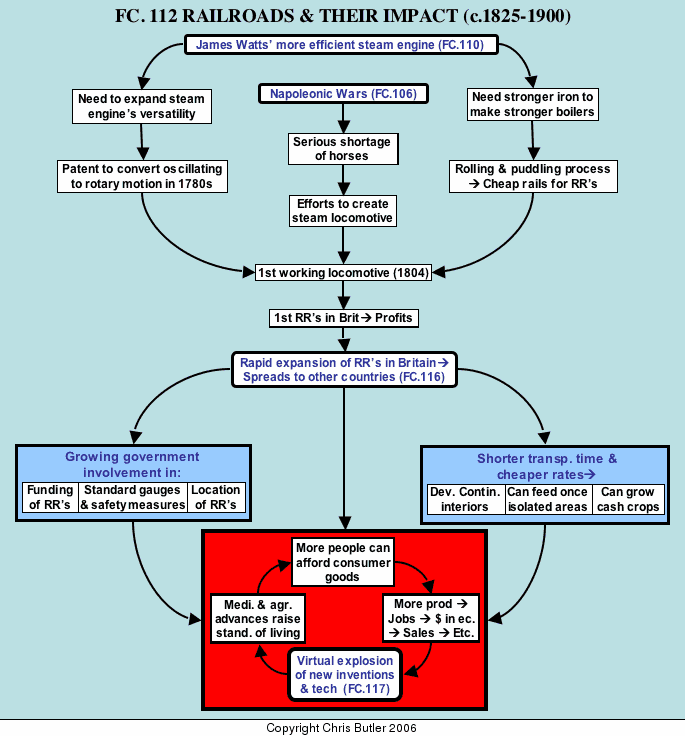FC112Railroads and Their Impact (c.1825-1900)
No invention of the 1800's played a more vital role in the Industrial Revolution than the steam locomotive and railroad, triggering the biggest leap in transportation technology in history. The technology central to railroads, the steam engine, needed two major improvements. First of all, a way had to be found to convert the oscillating motion of the steam engine to rotary motion so it could drive the locomotive's wheels. The solution came with James Watt's Sun and Planet gear, which connected the piston to the wheels somewhat off center to drive it forward. Secondly there was a need for stronger iron so boilers could create and withstand the pressure needed to drive steam locomotives. In 1783, the rolling and puddling process was invented, eliminating impurities in the iron and making it much stronger. In addition to creating much stronger boilers, it also led to stronger and cheaper iron rails on which the locomotives could ride.
Another catalyst for the invention of the locomotive was the loss of so many horses during the French Revolutionary and Napoleonic wars. This, along with the rolling and puddling method and Watt's Sun and Planet gear, sparked experiments leading to the first steam locomotive in 1804. However, it was not until the 1820's, when a properly running locomotive had been designed and the rolling and puddling technique had advanced and become widespread enough to make good cheap rails possible, that the first railroads were born.
In 1825, the Stockton and Darlington Railroad carried the first commercial freight of any railroad in history. Five years later, the Liverpool and Manchester Railroad opened operations carrying passengers as well as freight. This quickly sparked a virtual mania for building railroads in Europe and the United States after 1830. The 1800s saw incredible growth in the miles of track being laid. In 1830, Britain had only 95 miles of track. That figure had grown to 1500 miles by 1840 and 6600 miles by 1850. By contrast, Europe in 1850 had only 8000 miles of track. However, after 1850 Europe and the United States rapidly gained to Britain. By 1890, Britain had 20,000 miles of track, while Germany had 26,000 miles and the United States had 167,000 miles. Even Russia had 48,000 miles of track by 1900, although that was spread out over a vast area.
Such rapid expansion had both political and economic effects. Politically, the power of the state grew considerably. For one thing railroads were expensive to build, leading governments to finance them directly or through massive land grants. Also, everyone wanted railroads to pass through and benefit their regions. At first, this was impractical, and governments often had to step in and decide where the main trunk lines should be laid before less profitable branch lines could be developed. Finally, standard gauges (track sizes) and safety standards had to be set so that different railroads could easily link up and run their trains on other companies' tracks without crashing into one another. Naturally, each railroad wanted to avoid the expense of adapting its own gauge to another company's standard, making it necessary for the government to step in and impose a standard gauge and safety practices. Therefore, as railroads unified their nations economically, the governments directing their development unified their nations politically and increased their own power.
Railroads cut travel time by 90% and dramatically reduced freight costs with three important economic results. First, they made possible the settlement and development of continental interiors. For example, in 1869 the first transcontinental railroad across North America was completed, transforming an arduous and dangerous journey of months into an easy trip of a few days. This linked the countryside more tightly to the cities, production areas to markets and raw materials, and continental interiors to coastlines and waterways. Second, farmers switched from raising subsistence crops to cash crops better suited for their local soils, thus increasing crop yields dramatically. They could then sell the crops, buy the food needed to feed themselves, and still have money for buying consumer goods. Finally, areas previously isolated during famines could now be supplied, leading to fewer deaths from hunger and starvation and corresponding increases in population.
With factories more closely connected to markets and the larger population of potential consumers, many more people could afford consumer goods. This stimulated sales, providing more jobs, increased production, and lower prices. With business booming, companies developed new products, triggering a virtual explosion of new technological advances, inventions, and consumer products in the latter 1800's. All these advances led to a higher standard of living, which further increased the consumer market, starting the process all over again.
By 1900, railroads had virtually revolutionized overland transportation and travel, pulling whole continents tightly together (both economically and politically), helping create a higher standard of living, the modern consumer society, and a proliferation of new technologies. Although airplanes and automobiles would continue this revolution, it was the railroad that paved the way.
